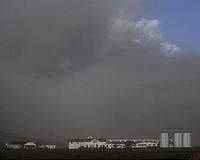| . |  |
. |
Reykjavik (AFP) May 22, 2011 Safety experts warned Sunday that ash from an erupting Icelandic volcano that closed the country's airspace may blow across large swathes of western Europe, raising fears of new flight chaos. Air safety officials said ash from the Grimsvoetn eruption may reach north Scotland by Tuesday before sweeping across Britain to hit France and Spain two days later. But experts said the impact should not be as far-reaching as 2010, when a similar event caused widespread flight cancellations. Ash deposits were sprinkled over the capital Reykjavik Sunday, some 400 kilometres (250 miles) to the west of the volcano, which has spewed an ash cloud about 20 kilometres into the sky. Less than 24 hours after the eruption began late Saturday, experts and authorities in Iceland said the volcanic activity had begun to decline. That has raised hopes that the ash plume might not be big enough to cause much trouble once the winds change. "It has been declining now a bit since this morning," Magnus Tummi Gudmundsson, a geophysicist at the University of Iceland, told AFP late Sunday. He stressed however that the eruption, with its column of smoke still stretching some 10 kilometres into the air, remained powerful. "It will have to decline considerably more before we can consider it of no danger," he said. Whether it will cause air travel chaos or not "will depend on the power of the eruption and the strength of the winds," he added. Fortunately, Gudmundsson said, so far "the winds are not nearly as strong as last time around." On that occasion, in April 2010, the nearby Eyjafjoell volcano erupted, spewing a massive cloud of ash that caused the planet's biggest airspace shutdown since World War II. "This time it is probably going to be more local." Oli Thor Arnason, a meteorologist at the Icelandic Meteorological Office, agreed. For ash from Iceland's most active volcano to reach mainland Europe, "the eruption has to keep on going as strong as it is now for the next couple of days" he said. Historically, Grimsvoetn eruptions have tended to have very brief explosive stages, with the intensity usually subsiding significantly within a few days. But residents living near Grimsvoetn saw little sign of improvement Sunday. "It's just black outside, and you can hardly tell it is supposed to be bright daylight," Bjorgvin Hardarsson, a farmer at Hunbakkar Farm in the nearby village of Kirkjubaejarklaustur, told AFP by phone. "You'd think it was night," said Vilhelm Tunnarsson, a photographer for local Icelandic media staying at a nearby hotel. At times he had been unable to see 30 centimetres (11 inches) in front of him, he added. "I went out a little this morning, and had ash in my eyes and mouth and nose. And I just went five metres (yards) to my car and back ... I was covered," he said. Rescue workers have been hard at work handing out masks and goggles and helping local farmers with their animals. Ash deposits from Grimsvoetn, Iceland's most active volcano located at the heart of its biggest glacier Vatnajoekull, even reached the capital, prompting Iceland's airport authority, Isavia, to announce the main airport Keflavik was shutting. The airspace closure "affects pretty much all of Iceland," Isavia spokeswoman Hjordis Gudmundsdottir told AFP Sunday morning. The situation remained unchanged all day, and by evening Gudmundsdottir said Iceland's airports would likely remain closed all night and into Monday morning. However, she stressed, with the winds blowing the ash to the north it was a far better situation than last year, when ash from Eyjafjoell was blown to the south and southeast over mainland Europe. Saturday's eruption was the most powerful in over a century at Grimsvoetn, which has erupted nine times between 1922 and 2004, a spokeswoman for the Icelandic Meteorological Office told AFP Sunday evening. European air safety organisation Eurocontrol said they expected no impact on European airspace outside Iceland or on transatlantic flights for at least 24 hours. When the Eyjafjoell eruption began in April 2010, orders were given to close vast swathes of European airspace for fear the ash could wreak havoc on aircraft engines. But experts said the ash generated by the latest eruption, a bit coarser and heavier, might not travel as far. "I don't expect this will have the same effect as Eyjafjoell volcano because the ash is not as fine," geologist Gunnar Gudmundsson told AFP. "The eruption is still going strong, but because the ash is basalt it is rougher and falls back down to earth much quicker." When it last erupted in November 2004, volcanic ash fell as far away as mainland Europe and caused minor disruptions in flights to and from Iceland.
Share This Article With Planet Earth
Related Links Bringing Order To A World Of Disasters When the Earth Quakes A world of storm and tempest
 Volcanic eruption shuts down Iceland airspace
Volcanic eruption shuts down Iceland airspaceReykjavik (AFP) May 22, 2011 Iceland's airspace temporarily closed down early Sunday because of a violent eruption of the country's most active volcano, the airport administration Isavia said. "The status right now is that Keflavik airport, our biggest international airport, is closing. The airspace is closing," Isavia spokeswoman Hjordis Gudmundsdottir told AFP. The airspace closure, she said, "affects pretty much ... read more |
|
| The content herein, unless otherwise known to be public domain, are Copyright 1995-2010 - SpaceDaily. AFP and UPI Wire Stories are copyright Agence France-Presse and United Press International. ESA Portal Reports are copyright European Space Agency. All NASA sourced material is public domain. Additional copyrights may apply in whole or part to other bona fide parties. Advertising does not imply endorsement,agreement or approval of any opinions, statements or information provided by SpaceDaily on any Web page published or hosted by SpaceDaily. Privacy Statement |